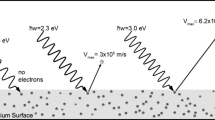Summary
The origin of electromagnetic radiation is traced to the state of motion of the radiating charge at the retarded time. By applying Poynting’s theorem and the hypothesis that the radiated power is equal to the time rate of change of the electromagnetic mass, the Lorentz-Dirac equation is recovered. Contrary to the usual interpretation, this derivation reveals that the Lorentz-Dirac equation does not need a fully covariant approach, being only a first-order inv/c consequence of the electromagnetic theory, as in the case of the existence of magnetic fields.
Riassunto
Si traccia l’origine della radiazione elettromagnetica rispetto allo stato di moto della carica radiante al tempo ritardato. Applicando il teorema di Poynting e l’ipotesi che la potenza irradiata è uguale alia velocita di cambiamento della massa elettromagnetica si recupera l’equazione di Lorentz-Dirac. Contrariamente alia solita interpretazione questa derivazione rivela ehe l’equazione di Lorentz-Dirac non necessita di un approccio interamente covariante essendo solo di primo ordine in conseguenza div/c della teoria elettromagnetica, come nel caso dell’esistenza di campi magnetici.
Резюме
Происхождение элект ромагнитного излучения связано с с остоянием движения излучающег о заряда в запаздываю щий момент времени. Применяя тео рему Пойнтинга и гипотезу, что мощность излучен ия равна скорости изменения электромагнитной ма ссы, заново выводится уравнение Лоренца-Дирака. В противоположность о бычной интерпретаци и, предложенный вывод п оказывает, что уравнение Лоренца-Ди рака не требует полно стью ковариантного подхо да и представляет только первый порядок по v/c электромагнитной те ории, как в случае существования магни тных полей.
Similar content being viewed by others
References
T. Erber:Fortsch. Phys.,9, 343 (1961).
B. H. Goedecke:Nuovo Cimento B,28, 225 (1975).
M. Planck:Ann. Phys. (Leipzig),63, 419 (1897).
J. L. Jiménez andI. Campos:Am. J. Phys.,55, 1017 (1987).
D. Bohm andM. Weinstein:Phys. Rev.,74, 1789 (1948).
See ref. (1), sect. 2.
P. A. M. Dirac:Proc. R. Soc. London, Ser. A,176, 148 (1938).
L. de la Peña, J. L. Jimenez andR. Montemayor:Nuovo Cimento B,69, 71 (1982).
Author information
Authors and Affiliations
Rights and permissions
About this article
Cite this article
Jiménez, J.L., Campos, I. A «Nonrelativistic» approach to the Lorentz-Dirac equation. Nuov Cim B 101, 687–696 (1988). https://doi.org/10.1007/BF02743624
Received:
Published:
Issue Date:
DOI: https://doi.org/10.1007/BF02743624



